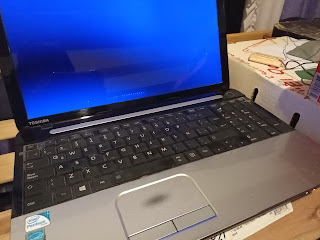In this tutorial you will learn how to root a LG tablet with LGONECLICKROOT and then how to dump the bulk data from internal storage partition to your PC. Let's start with the first and most tedious part, rooting and using cygwin, which must be linked to adb by using one or two methods available, This is not a very effective process but we doubt anyone of us have a FBI lab to read the contents of the memory directly with forensic equipment.
If you are getting the stuck screen at command prompt "SPECIAL COMMAND" like the one below it could be due to encryption. First decrypt the tablet doing a
complete backup because you could loose all your files in the process if something happens.
 |
| Stuck at "Special Command, enter, leave". |
By decrypting the tablet, it didn't stuck at the same screen but in the end of the running screen you are asked to type somehing.
1) Next step is to install BusyBox for Android, probably you don't need help here.
2) Once installed, re-encrypt the tablet including empty space sectors (FULL ENCRYPTION) and when the process is done connect the tablet to pc.
3) We hope you already linked android-sdk to cygwin so open a cygwin terminal and type manually
adb forward tcp:5555 tcp:5555 and press INTRO. In windows 8.1 the copy and paste failed and we don't recommend copy/paste method for some buggy reason pretty hard to explain here.
4) Enter the command
adb shell
5) Enter the command
su
*If it is the first time, you have to
grant permission by unlocking the screen and accepting any request made by the SUPERUSER If you missed, just re enter the command and next time the request will display on a tablet again, but for a few seconds.
 |
| Grant permission to SUPERUSER by unlocking the screen. |
 | | | | |
| Finally you will end with a screen like this. |
|
|
6) Enter the command (but for me only worked if I wrote manually):
/system/xbin/busybox nc -l -p 5555 -e /system/xbin/busybox dd if=/dev/block/mmcblk0p34
*nothing special happens, mmcblk_p__ could be differentl some tutorials will tell you to dump the entire flash memory and others will explain how to figure out which number is the partition containing your personal data.
7) Open another cygwin instance by clicking the shortcut again and enter:
a)
adb forward tcp:5555 tcp:5555
*nothing happens
b)
cd /nexus
c)
nc 127.0.0.1 5555 | pv -i 0.5 > mmcblk0p34.raw
* Vertical Bar is alt+0124,
source website.
* and you should see some flowing logs like:
 |
| Cygwin32 can run more than one instance for this job. You don't need cygwin64 in 64-but Windows OS |
And this could take some time, between half an hour and 45 minutes.
Then you can open a command prompt at android sdk platform tools folder to "eject" the tablet, in our test we just unplug it without risks but if you want to:
8) Finally you will end with a big file with around 11GB in size that you must convert with vhdtool.exe, again, using a command prompt. This will make the raw file we have just created readable by Windows. The process takes a few miliseconds!
 |
| The process of converting the raw file takes no time. |
9) Go to Nexus directory (the source website was recovering files from a
nexus tablet so, it kept as it) where you must have the vhdtool (it is
just a portable exe) and the mmcblk0p34.raw and open a command prompt to run the command:
vhdtool /convert mmcblk0p34.raw
 |
| VHDTool.exe will do the trick |
 |
| As shown before, the process is inmediate. |
10) Open the disk management console and attach a new vhd:
 |
| a) For sure you don't need help where to find the disk management console of Windows |
|
|
 |
| b) Browse for the file |
 |
| c) Select from the drop menu not to filter any extension *.* and open it. |
 |
| d) Click OK! |
 |
| e) Oops, this error could happen in Windows 8.1 |
f) Enable show hidden extensions and rename it from *.raw to *.vhd, don't care about the warning about changing the filename extension.
 |
| f) Enable show hidden extensions and rename it from *.raw to *.vhd |
 |
| g) Now you should be able to attach the vhd so repeat the process and initialize it as shown here: |
 |
| h) Select GPT partition |
i) Right Click over the disk to create a new volume with that information,
without formatting, with default allocation size.
 |
| i) Create a new volume with that information, without formatting, with default allocation size. |
 |
| j) Cancel the pop-up once new volume and letter are ready. |
11) Now go to My Computer and look for the new drive,
format with default allocation size iin
FAT32, using
quick mode!
12) Your drive should be ready to be scanned by Recuva. We don't recommend using another software as getdataback for fat because they don't have simple user interface, lot of options and in exchange this one will do the job with ease.























